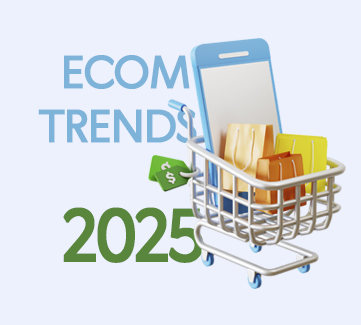The ecommerce industry continues to evolve rapidly, fueled by technological advancements, changing consumer behavior, and new market dynamics. As businesses look to the future, understanding and leveraging the latest trends is essential for staying competitive. This article explores the key ecommerce trends expected to shape 2025 and provides actionable insights for businesses aiming to thrive in this dynamic landscape.
6. The Rise of AI-Powered Personalization and Logistics

Artificial Intelligence (AI) is set to dominate ecommerce in 2025, driving hyper-personalized customer experiences.
• Hyper-Personalized Recommendations
AI algorithms analyze customer data to deliver tailored product recommendations, significantly boosting conversion rates. Retailers using machine learning can anticipate consumer needs based on browsing history, past purchases, waybills and even real-time behavior.
• Virtual Shopping Assistants
AI chatbots and virtual assistants are becoming increasingly sophisticated, offering personalized guidance, answering queries, and streamlining the purchasing process.
• Predictive Analytics
AI-powered tools enable businesses to forecast demand and trends, optimize inventory, and reduce waste by understanding what customers will need before they even know it themselves.
▼ Personalized Fulfillment Strategies
AI-driven analytics empower ecommerce businesses to optimize logistics by predicting demand trends and tailoring fulfillment strategies to customer behavior. For example, AI can analyze regional purchase patterns to pre-position inventory in all types of warehouses closer to high-demand areas, reducing delivery times and costs while for example selling supplements online.
▼ Dynamic Route Optimization
AI plays a crucial role in improving delivery logistics by dynamically planning the most efficient routes for shipments by courier services. Factors such as weather, traffic, and delivery urgency are considered, ensuring that orders reach customers quickly and reliably.
▼ Real-Time Inventory Updates
Advanced AI systems provide real-time updates on inventory levels, ensuring that customers never face disappointment due to stockouts. This data also helps businesses restock strategically, reducing overstock or understock situations making stock control easier.
▼ Enhancing Reverse Logistics
Returns management is a key aspect of logistics, and AI helps streamline this process by identifying patterns in returns and suggesting solutions, such as improving product descriptions or images to lower return rates. Efficient reverse logistics enhance customer satisfaction while controlling costs.
5. Sustainable and Ethical Shopping
As consumers grow more eco-conscious, sustainability is no longer optional—it’s a necessity.
Green Logistics
Expect to see wider adoption of electric delivery vehicles, eco-friendly packaging, and carbon-neutral shipping options. Consumers are actively choosing brands that minimize their environmental footprint.
Transparent Supply Chains
Shoppers demand transparency about where and how products are made. Ecommerce businesses that provide clear information about sourcing, labor practices, and sustainability efforts will gain customer trust.
4. Social Commerce Takes Center Stage
The integration of shopping features into social media platforms is redefining the ecommerce landscape.
Shoppable Videos and Livestreaming
Platforms like Instagram, TikTok, and YouTube are making it easier for consumers to purchase directly from content creators, blurring the lines between entertainment and shopping.
Influencer-Driven Purchases
Social proof remains powerful. Influencers and micro-influencers play a pivotal role in driving sales, especially when combined with direct “buy now” links embedded in their posts.
3. Cryptocurrency and Blockchain in Ecommerce

Digital currencies are reshaping payment systems and supply chain transparency.
Crypto Payments
An increasing number of businesses are accepting cryptocurrency, offering faster, secure, and borderless transactions. This trend caters to tech-savvy and privacy-conscious consumers.
Blockchain for Transparency
Blockchain technology ensures an immutable record of product origins, shipment tracking, and authenticity verification, helping combat counterfeit goods and enhance trust.
2. Voice Commerce Gains Momentum
Voice-activated technology is becoming a mainstream tool for online shopping.
Smart Speaker Integration
Devices like Amazon Echo and Google Nest allow customers to place orders, check delivery statuses, and reorder products through simple voice commands.
Optimizing for Voice Search
Businesses will need to adapt by using natural language processing (NLP) and optimizing product listings for voice-based search queries.
1. Augmented Reality (AR) for Immersive Shopping
Augmented Reality is revolutionizing the way customers experience products online.
Virtual Try-Ons
Consumers can visualize clothing, accessories, or home decor in real-time using AR tools, significantly reducing returns and increasing confidence in purchases.
Immersive Showrooms
Brands are creating virtual showrooms where shoppers can explore products interactively, simulating an in-store experience from the comfort of their homes.
Conclusion
The ecommerce landscape in 2025 will be shaped by technological innovation, sustainability, and evolving consumer expectations. Businesses that embrace AI, AR, voice commerce, and sustainable practices will thrive, while those that resist adaptation risk falling behind. With a trusted logistics partner like WAPI, businesses can confidently navigate these trends and unlock new opportunities for growth in the ever-changing world of ecommerce.



 Community
Community
